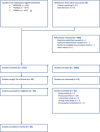Intravenous Medication Administration Errors in Hospitalised Patients: An Updated Systematic Review
- PMID: 40545841
- PMCID: PMC12183495
- DOI: 10.1111/jep.70167
Intravenous Medication Administration Errors in Hospitalised Patients: An Updated Systematic Review
Abstract
Background: Administering intravenous (IV) drugs carries a high risk of adverse effects due to their direct entry into circulation. Identifying the prevalence and types of IV administration errors and the drugs involved is crucial for implementing effective interventions to reduce such errors.
Aim: This systematic review aimed to examine and synthesise the available articles on medication errors involving IV administration in hospitalised patients.
Methods: A comprehensive search was conducted using electronic databases, including PubMed, Ovid Medline, and CINAHL. The search was performed without time limitation up to July 2023. However, only articles published in English and human subjects were included. The quality of the studies was appraised using the Newcastle-Ottawa quality assessment scale (NOS). This systematic review was registered with PROSPERO (CRD42023469352).
Result: Database searches yielded 2177 articles; after duplicate removal, 1717 underwent title and abstract screening, and 23 were included after full-text review. The studies were from 12 countries, and the multicentre study included countries from Europe, Africa, the Americas, Asia, and Australia. The majority of the studies were conducted in either teaching hospitals (n = 11) or university-affiliated hospitals (n = 7), with most involving direct observation (n = 21). IV administration errors exhibit a broad prevalence range of 5.0%-62.9%, involving various types such as wrong diluent, dose, route, rate, technique, omission, and timing. Studies lack uniformity in reporting, with some not specifying prevalence. The highest prevalence of specific errors varies across settings.
Conclusion: Our review highlights that IV medication error rates vary based on study design, setting, and population. Standardised definitions, reporting procedures, and reliable tracking methods are needed. Human factors, system issues, and environmental stressors influence medication errors. Future research must improve our understanding and address these factors to enhance patient safety and healthcare quality.
Keywords: hospitalised; intravenous; in‐patients; medication administration; medication errors.
© 2025 The Author(s). Journal of Evaluation in Clinical Practice published by John Wiley & Sons Ltd.
Conflict of interest statement
The authors declare no conflicts of interest.
References
-
- Maryland B., “Pharmacy–Nursing Shared Vision for Safe Medication Use in Hospitals: Executive Session Summary,” American Journal of Health‐System Pharmacy 60, no. 16 (2003): 13–19. - PubMed
-
- Peterson K., Anderson J., Bourne D., and Boundy E., Scoping Brief: Care Coordination Theoretical Models and Frameworks (2018). - PubMed
-
- McDowell S. E., Mt‐Isa S., Ashby D., and Ferner R. E., “Where Errors Occur in the Preparation and Administration of Intravenous Medicines: A Systematic Review and Bayesian Analysis,” BMJ Quality & Safety 19, no. 4 (August 2010): 341–345. - PubMed
Publication types
MeSH terms
Grants and funding
LinkOut - more resources
Full Text Sources
Medical


